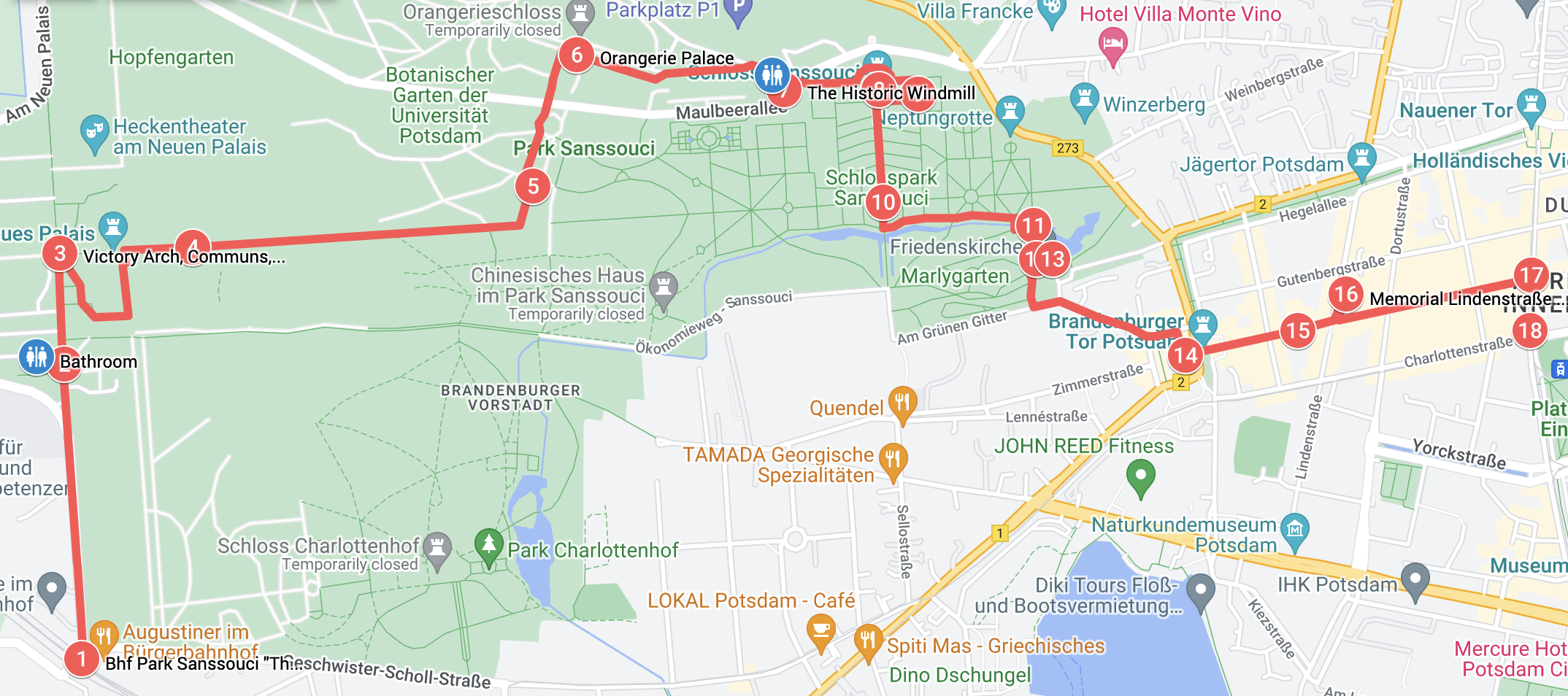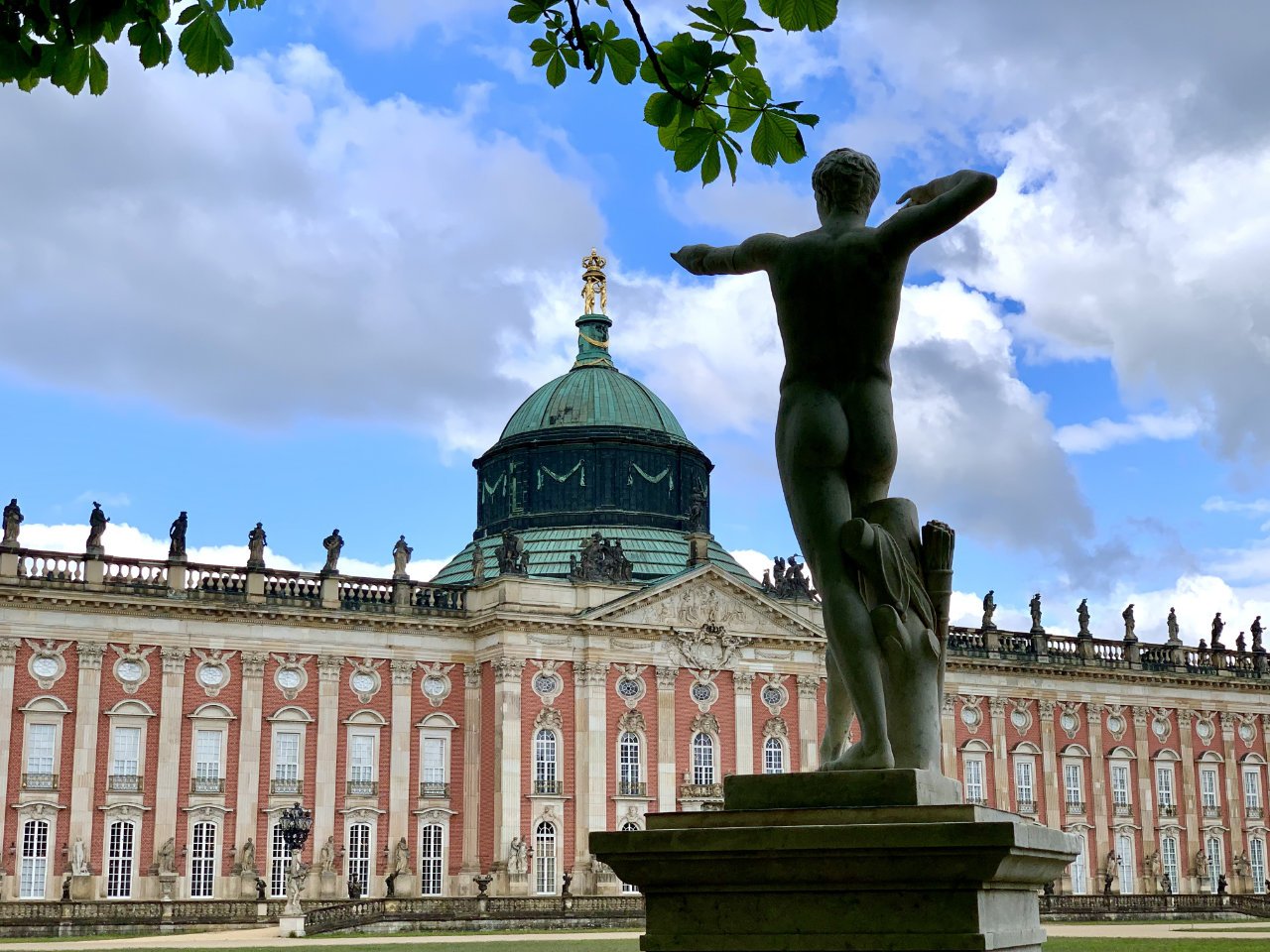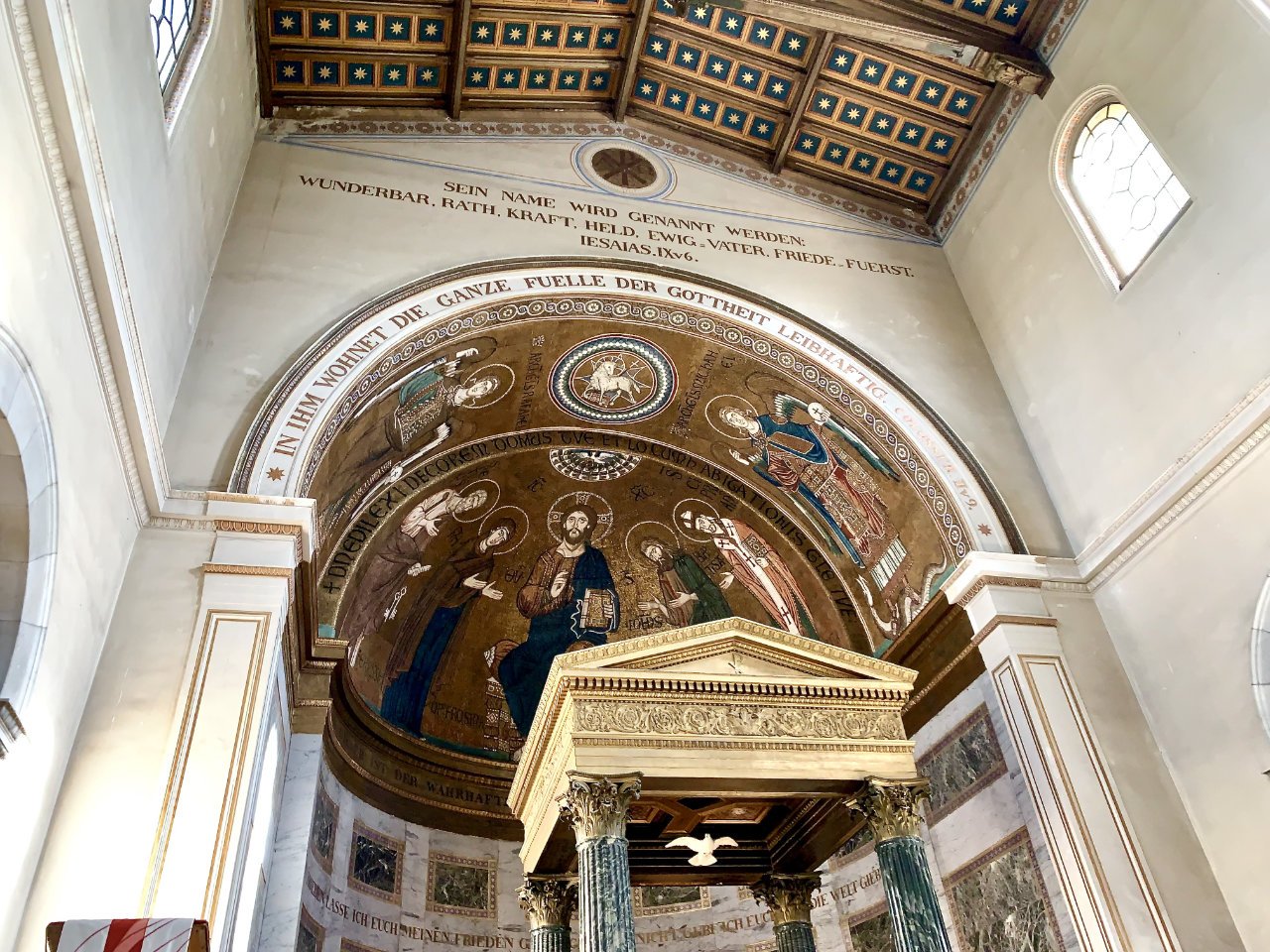Self-Guided Potsdam Walk through UNESCO World Heritage Sanssouci Gardens
Updated for 2024!
Want to visit Potsdam but not sure where to start? Here’s a self-guided walk that you can do in 4 hours including train travel to and from Berlin. See the sights and enjoy the Sanssouci gardens of Potsdam. The best of Potsdam by yourself in half a day.
Discover history with a Potsdam audio tour!
Want to try this fun self-guided Potsdam walk as an audio tour? Click the button below!
In this article, we’ll discuss how to get to Potsdam from Berlin on the train, where to stop for food and bathrooms, and how to get back to Berlin.
Use this map to explore the historic city of Potsdam on your own
Overview of self-guided Potsdam tour
Take the RE1 Regional Train from Alexanderplatz (or Friedrichstrasse or Hauptbahnhof) to Bahnhof Park Sanssouci
See the New Palace, Orangerie Palace, and Sanssouci Palace
Take a break for food and/or shopping
Head back to Berlin
Know before you go
Entrance to the Sanssouci park is free
You can travel in Berlin and Potsdam with an ABC 24-Hour Ticket
How to get to Potsdam Park Sanssouci from Berlin by train
The Sans Souci park has its own train station. You can get directly there from Berlin, no changes, by taking the RE1 Train. The RE1 leaves from Alexanderplatz at 33 minutes past the hour. It stops at Friedrichstrasse and Hauptbahnhof along the way, too. The journey takes around 30 minutes and there are bathrooms on the train.
1. The Kaiser Bahnhof
Arrive at what used to be the last Kaiser’s train station. This is where Wilhelm II fled Germany after WW1.
2. Entering Park Sanssouci
As you arrive there’s an information centre, bathroom, and a gift shop on your left. Entrance to the park is free, but if you want to visit any of the palaces you’ll have to pay.
Statue of Greek archer in front of the Potsdam’s New Palace
3. The New Palace and the Communs
The Communs (with the OTT beautiful staircases) used to be kitchens and servants’ quarters.
The New Palace was built in the 18th Century after Frederick the Great’s victory in the Seven Years’ War as a display of power. It sits at the Western end of what Frederick the Great called “The Axis of Might”. This was the favourite palace of Wilhelm II, who attempted to have his mother arrested here when he came to power in 1888. He would flee Germany from this palace 30 years later, shortly before the end of the First World War
4. The New Palace from the other side
Don’t forget to turn around as you’re walking away: the views are spectacular! Many of the statues adorning the palace are Greek demigods, perhaps an allusion to how Frederick the Great saw himself!
5. Frederick the Great Statue
Say hello to the man that built the gardens you’re now enjoying. The statue wasn’t here during his time, but it’s fitting these days. He faces the stunning Orangerie Palace.
Orangerie Palace in the Potsdam Sanssouci Gardens
6. The Orangerie Palace
Added in the mid-19th Century by Friedrich Wilhlem IV. Friedrich Wilhlem IV was a great fan of the Romantics, who inspired him to build this palace in the last years of his life. The palace is used to host the gardens’ exotic plants over the Winter.
7. The Historic Windmill
Yes, the windmill is real. That said, the original was the only part of the park destroyed in World War Two, as it was unintentionally smashed to pieces by Soviet artillery fire. The windmill has a cute cafe at the bottom, and of course you can go inside as well - worth it for the views over the Sanssouci palace and park!
There’s a lovely story about the windmill, too. The story goes that Frederick the Great found the windmill too noisy, and told the miller that he had to shut down his business, for the King cannot be bothered like this! The miller took the king to court, and the court found in favour of the miller. The windmill stayed put! The story isn’t necessarily true of course, it was used at the time to explain to 18th-Century Prussians with little education that this king, Frederick the Great, was different. He was himself a citizen of Prussia, subservient to Prussian law.
The beautiful gardens of Frederick the Great's Sanssouci Park
8. Sanssouci Palace
The main event! Frederick the Great’s ‘small vineyard house’. Not bad being king, eh? The palace is built in the Rococo style and is heavily inspired by the palaces of the French. Frederick the Great was particularly inspired by Louis XIV. The ‘humble’ palace has 12 rooms, and was used by the king to entertain guests every single night. Guests of his wrote diaries about how tedious they found these parties!
Top Tip: the gift shop here is actually pretty cool. Playmobil Frederick the Great is a personal favourite of mine!
9. Frederick the Great’s Grave
To thank kind Frederick the Great for popularising the potato in Prussia (and therefore later Germany) locals leave a potato on his grave. A smart man, Frederick the Great wanted to popularise the potato as to quickly and efficiently feed an entire nation. Discovering that they were unpopular, he devised a devious plan! He set up the King’s Very Special Potato Garden, told everyone how wonderfully delicious his potatoes were, and posted guards around the outside. He warned everyone: ‘do not steal my potatoes!’... and guess what? They did! They loved them! Thanks to Frederick the Great potatoes are now beloved all across Germany.
10. The Great Fountain
My favourite view of the park, looking up at the gorgeous palace. You can see grape vines growing on the terraces. The fountain sits where the East-West Axis of Might and the North-South Axis of Wisdom meet. Of course, Frederick the Great, the philosopher King, has his palace at the top of the Axis of Wisdom.
11. Photo point: Church of Peace
There’s a great sneaky photo point here where you can see the magnificent church over the water. This can be quite tricky to find, but it’s a lovely, quiet spot.
12. Kaiser Wilhelm’s Tomb
See where the first emperor (Kaiser) of Germany is buried. Wilhlem I was the brother of Friedrich Wilhlem IV, who added the Church of Peace to the gardens. Prince Regent from 1858, he became King in 1861. He would become the first Kaiser of a unified Germany in 1871 following Prussia’s victory over France. Prussia and their allies sealed the deal in the palace of Versailles, outside of Paris. Versailles and its gardens were of course Frederick the Great’s major inspiration for the Sanssouci Gardens.
13th Century Venetian Mosaic in the Church of Peace in the Sanssouci Gardens
13. The Church of Peace
Entrance to the church is free (donations are welcome!). The mosaic above the altar is originally from Venice and was saved from destruction by king Friedrich Wilhelm IV in the 19th Century. When visiting Venice he saw a church being demolished. Being a great lover of art, history, and particularly architecture, the king had the mosaic rescued and brought home to Prussia.
To the left of the altar, you can visit the graves of Friedrich Wilhelm IV, his wife, and their children, who sadly died very young.
14. The Brandenburg Gate
Yes, Potsdam has its own Brandenburg Gate. It’s much prettier than Berlin’s, don’t you think? After the Seven Years’ War the Gate was built to show that Prussia may be exhausted, but was not to be written off. Truthfully, they couldn’t really afford such a thing at the time. The War had seen Frederick the Great racing to the frontlines, commanding his armies and enjoying his mobile library he’d brought with him. He managed to fight off France, Austria, and Russia all at the same time, though the war was very costly for Prussia (despite being heavily funded by the British).
15. Brandenburger Strasse
As you pass through the Gate you enter the old city of Potsdam. The street before you is filled with cafes and cute shops. Stop off in a German bakery for a big, juicy pretzel, sit out in the sun with an ice cream or a beer, or even sneak off into the side streets for a lovely coffee and cake.
16. Memorial in Lindenstrasse
Partway up Brandenburger Strasse, on the left-hand side, you’ll discover that Potsdam didn’t escape the brutal history of the 20th Century. There is a building in Lindenstrasse that was used for nefarious means by both the Nazis and the communists. Originally a prison, the Nazis used the building as a ‘hereditary health court’, meaning that this is where they took mentally and physically disabled people away to be euthanised. Following the Nazis’ defeat the KGB and later the Stasi (East Germany’s secret police) would use the building as a prison. Potsdamers rightly used to fear this address.
17. Tram for Potsdam Hauptbahnhof
At the end of Brandenburger Strasse you’ll find a tram stop. The 92 & 96 trams will take you back to Potsdam’s main station (Hauptbahnhof) from here. You can get back to Berlin on the S-Bahn trains that leave every 10 minutes. Those trains stop at Zoo station, Hauptnahnhof, Friedrichstrasse, and Alexanderplatz among many others.
18. Please leave a Google Review
Did you enjoy this free walk? Please leave a review. Leaving a review on Google helps my small independent business get more direct bookings. Click here to leave a five-star review.
Sanssouci: Frederick the Great's favourite palace
Book a private Potsdam tour
Want to visit Potsdam? Whether you’re travelling alone or with a large group needing multiple guides, I can show you the sights. Did you know that there is a second park filled with palaces in Potsdam? That’s where the Potsdam Conference was held between Truman, Stalin, and Churchill after World War Two. Click here to book a private Potsdam tour!
















